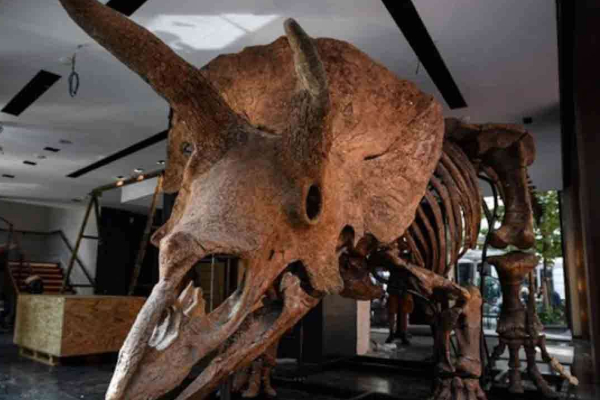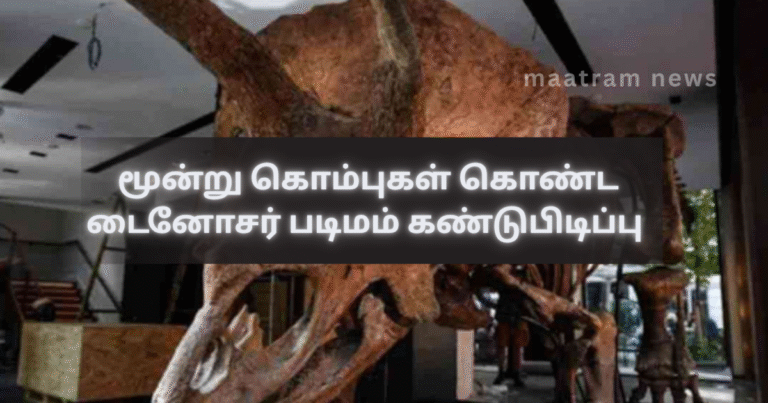இந்தியாவின் உத்தரப் பிரதேச மாநிலத்தின் Triceratops Fossil with Three Horns Discovered சஹாரன்பூர் மாவட்டத்தில் உள்ள சஹான்சாரா ஆற்றின் கரையில் மேற்கொள்ளப்பட்ட அகழ்வாராய்ச்சியின் போது, ‘ட்ரைசெரடொப்ஸ்’ (Triceratops) எனப்படும் மூன்று கொம்புகள் கொண்ட டைனோசரின் படிமம் கண்டுபிடிக்கப்பட்டதாக ஆராய்ச்சியாளர்கள் தெரிவிக்கின்றனர்.
தற்போது மேற்கொள்ளப்பட்ட சோதனைகளின் மூலம், இந்தப் படிமம் மில்லியன் கணக்கான ஆண்டுகள் பழமையானதாக இருக்கலாம் என்று தெரியவந்துள்ளது.
இந்த வகை டைனோசர்கள் கிரெடேசியஸ் காலத்தில், அதாவது 100.5 மில்லியன் ஆண்டுகளுக்கு முன்னர் வாழ்ந்ததாகத் தெரிவிக்கப்படுகிறது.
சமீபத்திய ஆண்டுகளில் இப்பகுதியில் மேற்கொள்ளப்பட்ட அகழ்வாராய்ச்சிகளில் மில்லியன் கணக்கான ஆண்டுகள் பழமையான பல படிமங்கள் கண்டுபிடிக்கப்பட்டுள்ளதாகவும் வெளிநாட்டு ஊடகங்கள் செய்தி வெளியிட்டுள்ளன.

எவ்வாறாயினும், இது குறித்து கருத்துத் தெரிவித்த ‘இயற்கை வரலாறு மற்றும் பாதுகாப்பு மையத்தின்’ (Natural History and Conservation Centre) நிறுவனர், 35 முதல் 40 மில்லியன் ஆண்டுகளாக இமயமலை அடிவாரத்தில் புதைந்திருந்த இந்தப் படிமம் பாதுகாப்பதற்கு இலகுவான நிலையில் உள்ளதாகக் கூறுகிறார்.
மேலும், இது மிகவும் முக்கியமான ஒரு கண்டுபிடிப்பு என்றும் அவர் குறிப்பிட்டுள்ளார்.
மேலதிக தகவல்களுக்கு மாற்றம் செய்திகள் இணையத்தளத்தினுள் பிரவேசியுங்கள்.
மேலதிக தகவல்களை உடனுக்குடன் பெற்றுக்கொள்ள மாற்றம் செய்திகள் முகநூல் பக்கத்தை பின்தொடரவும்.
Triceratops Fossil with Three Horns Discovered
Researchers have reported the discovery of a fossil of a three-horned dinosaur called Triceratops during excavations along the banks of the Saharanpura River in Saharanpur district, Uttar Pradesh, India.
Preliminary tests indicate that this fossil could be millions of years old.
These types of dinosaurs are believed to have lived during the Cretaceous period, approximately 100.5 million years ago.
In recent years, several million-year-old fossils have been unearthed in this region, according to reports in international media.
However, the founder of the Natural History and Conservation Centre has stated that this fossil, which had been buried at the foothills of the Himalayas for 35–40 million years, is in a condition that makes it relatively easy to preserve.
He also emphasized that this is a highly significant discovery.



